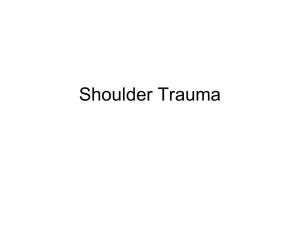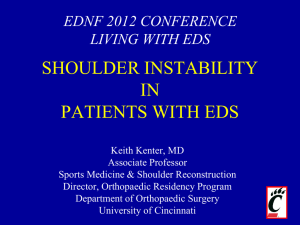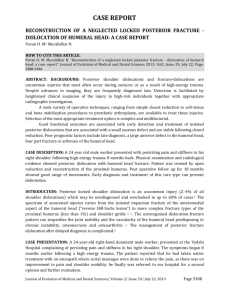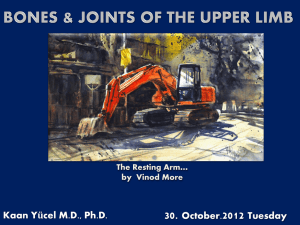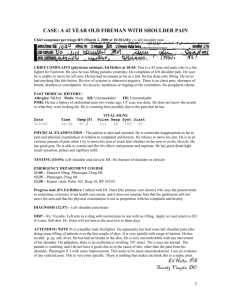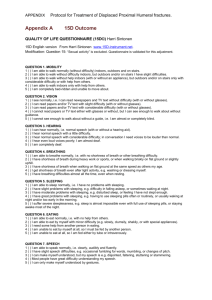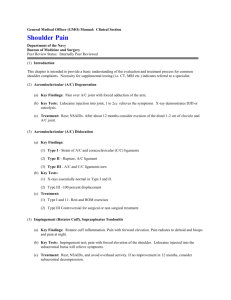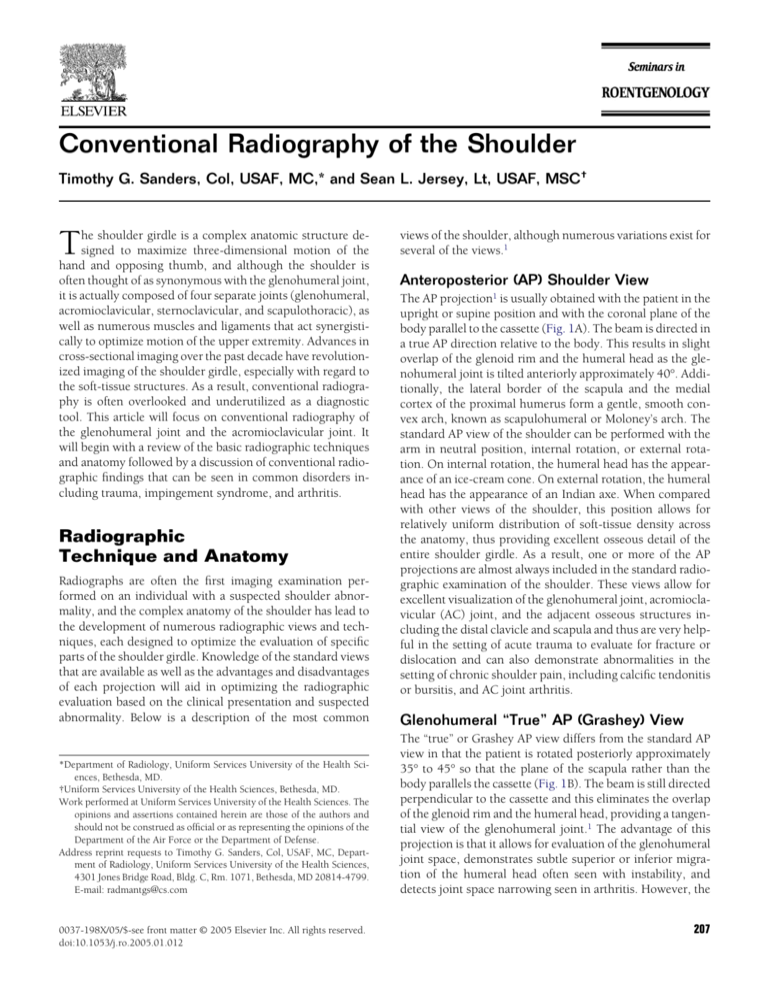
Conventional Radiography of the Shoulder
Timothy G. Sanders, Col, USAF, MC,* and Sean L. Jersey, Lt, USAF, MSC†
T
he shoulder girdle is a complex anatomic structure designed to maximize three-dimensional motion of the
hand and opposing thumb, and although the shoulder is
often thought of as synonymous with the glenohumeral joint,
it is actually composed of four separate joints (glenohumeral,
acromioclavicular, sternoclavicular, and scapulothoracic), as
well as numerous muscles and ligaments that act synergistically to optimize motion of the upper extremity. Advances in
cross-sectional imaging over the past decade have revolutionized imaging of the shoulder girdle, especially with regard to
the soft-tissue structures. As a result, conventional radiography is often overlooked and underutilized as a diagnostic
tool. This article will focus on conventional radiography of
the glenohumeral joint and the acromioclavicular joint. It
will begin with a review of the basic radiographic techniques
and anatomy followed by a discussion of conventional radiographic findings that can be seen in common disorders including trauma, impingement syndrome, and arthritis.
Radiographic
Technique and Anatomy
Radiographs are often the first imaging examination performed on an individual with a suspected shoulder abnormality, and the complex anatomy of the shoulder has lead to
the development of numerous radiographic views and techniques, each designed to optimize the evaluation of specific
parts of the shoulder girdle. Knowledge of the standard views
that are available as well as the advantages and disadvantages
of each projection will aid in optimizing the radiographic
evaluation based on the clinical presentation and suspected
abnormality. Below is a description of the most common
*Department of Radiology, Uniform Services University of the Health Sciences, Bethesda, MD.
†Uniform Services University of the Health Sciences, Bethesda, MD.
Work performed at Uniform Services University of the Health Sciences. The
opinions and assertions contained herein are those of the authors and
should not be construed as official or as representing the opinions of the
Department of the Air Force or the Department of Defense.
Address reprint requests to Timothy G. Sanders, Col, USAF, MC, Department of Radiology, Uniform Services University of the Health Sciences,
4301 Jones Bridge Road, Bldg. C, Rm. 1071, Bethesda, MD 20814-4799.
E-mail: radmantgs@cs.com
0037-198X/05/$-see front matter © 2005 Elsevier Inc. All rights reserved.
doi:10.1053/j.ro.2005.01.012
views of the shoulder, although numerous variations exist for
several of the views.1
Anteroposterior (AP) Shoulder View
The AP projection1 is usually obtained with the patient in the
upright or supine position and with the coronal plane of the
body parallel to the cassette (Fig. 1A). The beam is directed in
a true AP direction relative to the body. This results in slight
overlap of the glenoid rim and the humeral head as the glenohumeral joint is tilted anteriorly approximately 40°. Additionally, the lateral border of the scapula and the medial
cortex of the proximal humerus form a gentle, smooth convex arch, known as scapulohumeral or Moloney’s arch. The
standard AP view of the shoulder can be performed with the
arm in neutral position, internal rotation, or external rotation. On internal rotation, the humeral head has the appearance of an ice-cream cone. On external rotation, the humeral
head has the appearance of an Indian axe. When compared
with other views of the shoulder, this position allows for
relatively uniform distribution of soft-tissue density across
the anatomy, thus providing excellent osseous detail of the
entire shoulder girdle. As a result, one or more of the AP
projections are almost always included in the standard radiographic examination of the shoulder. These views allow for
excellent visualization of the glenohumeral joint, acromioclavicular (AC) joint, and the adjacent osseous structures including the distal clavicle and scapula and thus are very helpful in the setting of acute trauma to evaluate for fracture or
dislocation and can also demonstrate abnormalities in the
setting of chronic shoulder pain, including calcific tendonitis
or bursitis, and AC joint arthritis.
Glenohumeral “True” AP (Grashey) View
The “true” or Grashey AP view differs from the standard AP
view in that the patient is rotated posteriorly approximately
35° to 45° so that the plane of the scapula rather than the
body parallels the cassette (Fig. 1B). The beam is still directed
perpendicular to the cassette and this eliminates the overlap
of the glenoid rim and the humeral head, providing a tangential view of the glenohumeral joint.1 The advantage of this
projection is that it allows for evaluation of the glenohumeral
joint space, demonstrates subtle superior or inferior migration of the humeral head often seen with instability, and
detects joint space narrowing seen in arthritis. However, the
207
T.G. Sanders and S.L. Jersey
208
Figure 1 (A) AP view of shoulder in external rotation. (B) AP view of glenohumeral joint (Grashey view). (C) Axillary
view of shoulder. (D) Scapular “Y” view of shoulder. (E) Stryker notch view of shoulder.
obliquity results in a rapid change of overlying soft-tissue
density, which decreases the quality and visualization of the
osseous detail. The acromion, AC joint, and distal clavicle are
more difficult to evaluate than on the standard AP view.
Axillary Lateral View
The axillary view2 is typically obtained with the patient supine and the arm abducted 90°, although several variations3-8
of this view have been developed that require less than 90° of
abduction (Fig. 1C). The beam is centered over the midglenohumeral joint and is directed in a distal-to-proximal
direction while tilted approximately 15° to 30° toward the
spine. This results in a tangential view of the glenohumeral
joint from below and is an excellent method for evaluating for
anterior or posterior glenohumeral subluxation or dislocation and may also be helpful in the detection of an osseous
Bankart fracture involving the anterior glenoid rim. The radiographic quality is often very limited because of the rapid
change of overlying soft-tissue density. The osseous detail is
often quite poor, but the main value of the projection is in the
evaluation of glenohumeral subluxation or dislocation. In the
setting of acute trauma, it may be very difficult to obtain this
Conventional radiography of the shoulder
projection, as the patient may be unable to adequately abduct
the arm. Numerous variations of the standard axillary view
have been developed, some to minimize required abduction
of the arm in the setting of acute trauma, others to emphasize
certain anatomic features. The West Point View is one example
of a variation of the lateral axillary view that was developed to
improve detection of a Bankart fracture of the anterior glenoid rim.9 It is obtained by placing the patient in the prone
position with the arm abducted 90° from the long axis of the
body with the elbow and forearm hanging off the side of the
table. The beam is directed 15° to 25° in an inferior-to-superior direction and tilted 25° toward the spine. Although this
projection improves detection of an osseous Bankart lesion, it
can be difficult if not impossible to obtain in the setting of
acute trauma.
209
Table 1 Checklist in the Radiographic Evaluation of the Shoulder
Check lung for nodule, Pancoast tumor, pneumothorax
and adenopathy
Check acromioclavicular joint for separation or
osteolysis
Check glenohumeral joint for
Normal half-moon overlap between the glenoid and
humeral head
Normal scapulohumeral or Moloney’s arch
Check glenoid for Bankart lesion or rim fracture
Check humeral head for
Hill–Sachs lesion or trough line “reverse Hill–Sachs
lesion”
Centering over glenoid fossa on scapular Y-view
Check greater tuberosity for occult fracture
Scapular “Y” View
The scapular Y view10 is obtained with the patient upright or
prone with the anterior aspect of the affected side rotated 30°
to 45° toward the cassette (Fig. 1D). The scapular body is
seen in tangent and the glenoid fossa is seen en face as a
“Y”-shaped intersection of the scapular body, acromion process, and coracoid process. The humeral head should be
centered over the glenoid fossa. This view can be very helpful
in the setting of acute trauma to evaluate for anterior or
posterior dislocation as the patient can be imaged with little
or no movement of the arm and the projection obtains a
lateral projection of the glenohumeral joint. This view is also
useful for delineating fractures of the coracoid process, scapula,
acromion process, and proximal humeral shaft. The scapular Y
view is also used to evaluate the contour of the undersurface of
the acromion process when “typing” the acromion.
Stryker Notch View
The Stryker notch view11 can be obtained with the patient in
the supine or upright position. The arm is extended vertically
overhead; elbow is flexed, and the hand is supported on the
back of the head (Fig. 1E). The beam is directed toward the
mid axilla and is tilted 10° cephalic. This view nicely demonstrates the posterolateral aspect of the humeral head and is
excellent for depicting a Hill–Sachs deformity or flattening of
the posterolateral humeral head. Evaluation of glenoid rim
fractures or subtle glenohumeral subluxation is limited on
this view.
Acromioclavicular Articulations AP and PA
Projections
The AC joints are best evaluated in the erect position (either
sitting or standing) with the back of the patient flat against
the cassette.1 The arms should hang freely at the sides and the
patient may hold sandbags of equal weight in each hand. The
addition of weights will accentuate AC joint separation by
demonstrating elevation of the distal clavicle on the injured
side. The beam is directed toward the midline of the body at
the level of the AC joints. This projection can be used to
demonstrate AC joint pathology including fracture, separation, and arthritis. Comparison of the contralateral side can
often aid in the detection of subtle abnormalities involving
the AC joint.
Table 1 is a checklist of the important landmarks in the
radiographic evaluation of the shoulder.
Trauma
Trauma is a common indication for obtaining radiographs of
the shoulder and indeed radiography is often the first imaging study to be performed in the setting of shoulder pain
following trauma. The specific injury is usually dependent on
both the age of the patient as well as the mechanism of injury,
and the most common injuries include AC joint separation,
fracture of the clavicle, scapula, or proximal humerus, and
glenohumeral dislocation. Selection of the proper radiographic views as well as a working knowledge of the normal
radiographic anatomy and an understanding of the common
radiographic signs of injury will ensure the most accurate
assessment with conventional radiographs.
AC Joint Trauma
AC joint injuries are common and typically result from a
direct blow to the shoulder or as the result of a fall with the
patient landing directly on the distal tip of the clavicle. The
proper radiographic technique for evaluation of the AC joint
has been described above and comparison with the contralateral AC joint is often helpful. A three-point grading system is
used to classify AC joint injuries.12-14 A mild (Grade I) injury
leads to stretching of the AC ligaments without disruption of
the joint capsule and presents with point tenderness to palpation but normal radiographs (Fig. 2A). A moderate (Grade
II) injury results in disruption of the AC ligaments and widening of the AC joint. The coracoclavicular ligament may be
stretched but remains intact. Radiographically, the distal tip
of the clavicle is slightly elevated relative to the acromion, but
there is still some contact between the distal clavicle and
acromion (Fig. 2B). A severe (Grade III) injury results in
complete disruption of both the AC ligaments and the coracoclavicular ligament and presents radiographically as elevation of the distal tip of the clavicle. There is usually no contact
T.G. Sanders and S.L. Jersey
210
Figure 3 Posttraumatic osteolysis of distal clavicle. This patient experienced prior Grade II sprain of AC joint and now demonstrates
slight elevation of distal tip of the clavicle. There is also loss of
normal cortical white line (arrow) of distal tip of clavicle with minimal lucency involving distal clavicle.
to-moderate sprain of the AC joint (Fig. 3). It results in pain
that is typically self-limiting with resolution of symptoms
over several months. In the early stages, radiographically
there is loss of the normal cortical white line of the distal
clavicle and findings may progress to include resorption of
the distal 1 to 2 cm of the clavicle; however, the acromion
remains normal in appearance. During the healing phase, a
portion of the distal clavicle may reconstitute; however, the
distal cortex usually remains indistinct with occasional subchondral sclerosis or cyst formation.15-17 Differential diagnosis includes rheumatoid arthritis, hyperparathyroidism, and
infection (Table 2).
Scapular Fractures
Figure 2 (A) Grade I sprain of AC joint. AP view of shoulder in
patient with pain and point tenderness of AC joint after fall onto
shoulder demonstrates normal appearing AC joint (arrow) with no
separation or fracture. (B) Grade II sprain of AC joint. AP view of
shoulder demonstrates slight elevation of distal tip of clavicle. This
is consistent with disruption of AC joint capsule; however, coracoclavicular ligament remains intact preventing distal clavicle from
completely separating from adjacent acromion. (C) Grade III sprain
of AC joint. AP view of shoulder demonstrates complete separation
of AC joint (arrow) and disruption of coracoclavicular ligament
allowing marked elevation of distal tip of clavicle.
Scapular fractures are uncommon, but when they do occur
they usually result from significant direct trauma. The scapula is covered and protected by extensive musculature including the rotator cuff muscles, which usually function to
hold the fragments in near anatomic position following fracture, thus minimizing the clinical significance of these fractures. The most common mechanism of injury is direct
trauma during a motor vehicle accident, and although most
scapular fractures are visible on conventional radiographs of
Table 2 Potential Causes of Resorption of Distal Clavicle,
“SHARP”
between the distal clavicle and the acromion and widening of
the coracoclavicular distance may also occur (Fig. 2C).
Posttraumatic osteolysis of the distal clavicle can occur as a
result of chronic repetitive microtrauma to the AC joint as
seen in weightlifters or can occur following a one-time mild-
Septic arthritis
Hyperparathyroidism
Ankylosing spondylitis, Amyloid arthropathy
Rheumatoid arthritis
Posttraumatic osteolysis
Conventional radiography of the shoulder
Figure 4 Scapular fracture. Chest radiograph in this patient following motor vehicle accident demonstrates mildly displaced fracture
(arrowheads) of body of scapula. An inlay of CT scan clearly delineates extent of fracture (arrows).
211
Figure 6 Two-part Neer fracture. AP view of shoulder demonstrates
two-part Neer fracture. Greater tuberosity (long arrow) is displaced
greater than 1 cm from humeral head fragment (short arrow), which
remains in near anatomic position.
the chest, they are frequently overlooked because attention is
diverted to other more serious injuries of the head, abdomen,
or thorax.18 Fractures of the glenoid, coracoid, and acromion
can be associated with dislocation or direct trauma.19 Ossification centers of the coracoid, scapular body, and acromion
have a typical radiographic appearance and should not be
misinterpreted as a fracture. Although scapular fractures are
usually visible on conventional radiographs, the extent and
complexity of fracture are best delineated with CT imaging
(Fig. 4).
Proximal Humerus Fractures
Figure 5 Neer classification scheme of proximal humeral fractures.
Artwork demonstrates four components used in Neer classification
scheme.
Fractures of the proximal humerus occur in all age groups
but are most common in patients over 50 years of age, and
typically result from a fall on an outstretched arm or secondary to direct trauma. Neer developed a four-part classification
scheme as a means of describing proximal humeral fractures
and predicting clinical outcomes.20 The system uses the four
components of the humeral head, which include the anatomic neck, surgical neck, greater tuberosity, and lesser tuberosity (Fig. 5). To be considered significantly displaced, a
fracture fragment must be angulated more than 45° or must
be displaced greater than 1 cm from its original position. A
one-part fracture is one in which no fragment is significantly
displaced or angulated, while significant displacement or angulation of a single fragment is referred to as a two-part
fracture, and significant displacement of two fragments is
referred to as a three-part fracture (Fig. 6). A four-part fracture refers to a severely comminuted fracture with significant
displacement or angulation of its fragments. One-part fractures occur most commonly and are usually treated with
closed reduction with most patients experiencing good functional recovery. Prognosis for full functional recovery de-
212
T.G. Sanders and S.L. Jersey
Figure 7 Anterior shoulder dislocation. (A) AP view of glenohumeral
joint demonstrates anterior dislocation of humeral head (arrow). Notice
that humeral head has moved medially and inferiorly and sits below
coracoid process. This type of dislocation has also been termed subcoracoid dislocation. (B) Axillary view and (C) scapular Y view demonstrate anterior dislocation of humeral head (arrow) relative to glenoid
fossa (arrowhead).
clines and the risk for complications such as avascular necrosis of the humeral head worsens with increasing numbers of
fracture parts.21
Glenohumeral Dislocation
The anatomic configuration of the glenohumeral joint provides for tremendous range of motion but at the price of
instability as the humeral head is dislocated more than any
other single joint in the body. Approximately 95% of all
dislocations are anterior in direction, but the humeral head
may also dislocate posteriorly, inferiorly (luxatio erecta), or
in a superior direction.22,23
Anterior glenohumeral dislocations typically result from a
fall on an outstretched arm with the arm in slight abduction
at the time of impact. During anterior dislocation, the humeral head moves anteriorly, inferiorly, and medially, typically coming to rest beneath the coracoid process, thus making anterior dislocation easy to detect on conventional
radiographs (Fig. 7A-C).24 First-time dislocation in a young
person (under 35 years of age) usually results in a tear or
avulsion of the anterior labroligamentous complex from the
inferior glenoid, referred to as a Bankart lesion.25 A Bankart
fracture refers to an injury that includes not only an anterior
labral injury but also a fracture of the anteroinferior glenoid
(Fig. 8A and B). Impaction of the posterosuperior humeral
head against the inferior glenoid rim can result in an impaction fracture of the humeral head referred to as a Hill–Sachs
defect (Fig. 9). Less commonly, the inferior glenohumeral
Conventional radiography of the shoulder
213
The Hill–Sachs defect is usually best depicted on the AP
radiograph of the shoulder with the arm in internal rotation
and appears as an area of flattening or concavity of the posterolateral aspect of the humeral head (Fig. 9). The Stryker
Notch view is also very useful in depicting a Hill–Sachs defect, whereas the defect may be completely obscured on the
axillary view or AP radiograph with external rotation. Osseous Bankart lesions involving the inferior glenoid rim are
often subtle lesions that are best depicted on either the AP or
the axillary view of the shoulder. The West Point axillary
view as described above is a special adaptation of the axillary
view that was developed to accentuate detection of a Bankart
lesion.9
Table 3 summarizes the radiographic findings of anterior
glenohumeral dislocation.
Posterior glenohumeral dislocation differs from anterior
dislocation in that the mechanism of injury is a fall on an
outstretched arm with the arm in adduction rather than abduction. Violent muscle contractions associated with seizure
or electrocution is the classic mechanism leading to posterior
glenohumeral dislocation; however, this type of dislocation
may also result from a fall on an outstretched flexed and
adducted arm. This has been reported most commonly in
bicyclists and skiers, but can also occur in other athletic
sports. Unlike anterior dislocation, the radiographic findings
of acute posterior dislocation are subtle and often difficult to
detect, often resulting in a delay of the proper diagnosis.
Patients typically present clinically with a painful shoulder
that is adducted and locked in internal rotation.29 The humeral head is fixed to the posterior glenoid, thus preventing
external rotation or abduction of the arm without extreme
pain, and this constellation of findings can be misdiagnosed
as a frozen shoulder.30 Visual inspection demonstrates loss of
the characteristic rounded appearance of the shoulder and
may reveal a prominence posteriorly, coupled with flattening
of the anterior shoulder and a prominent coracoid process.
Figure 8 Bankart fracture. (A) Axillary view of glenohumeral joint
demonstrates small fracture fragment (arrow) adjacent to anterior
glenoid. This fracture results from impaction injury of humeral head
against anteroinferior glenoid rim and can lead to recurrent instability of glenohumeral joint. (B) Axial T1-weighted MR image with
intraarticular gadolinium demonstrates minimally displaced Bankart fracture (arrow).
ligament is avulsed from its humeral attachment, which may
be detected radiographically if there is an associated bony
avulsion, known as bony humeral avulsion of the glenohumeral ligament (BHAGL). First-time dislocators over the age
of 35 are less likely to develop a Bankart lesion of the anteroinferior labrum. Instead, this group of individuals usually
experiences either disruption of the rotator cuff, avulsion of
the greater tuberosity (Fig. 10A and B), or avulsion of the
subscapularis muscle and anterior capsule from the lesser
tuberosity.26 Although radiographs can demonstrate the osseous injuries that result from anterior dislocation, soft-tissue
injuries of the capsule and labrum are best evaluated with
magnetic resonance (MR) imaging with or without the addition of intraarticular contrast.27,28
Figure 9 Hill–Sachs defect. True AP radiograph of glenohumeral
joint demonstrates flattening (arrow) of posterosuperior aspect of
humeral head consistent with Hill–Sachs defect. This flattening results from impaction of humeral head against anteroinferior glenoid
rim at time of anterior dislocation.
T.G. Sanders and S.L. Jersey
214
Figure 10 Greater tuberosity avulsion fracture. (A) AP radiograph of
shoulder demonstrates displaced avulsion fracture of greater tuberosity (arrow) resulting from an anterior dislocation. This injury is
more likely to occur in patients over 35 years of age and occasionally
these fractures are non-displaced and radiographically occult. (B)
T1-weighted coronal MR image of shoulder demonstrates non-displaced avulsion fracture (arrow) of greater tuberosity in middleaged man status post anterior shoulder dislocation. This fracture
was occult radiographically.
These physical findings are often subtle and, depending on
the mechanism of injury, associated fractures of the scapula,
coracoid, or humerus may further complicate recognition of
posterior dislocation. For these reasons, proper radiographic
evaluation with a high index of suspicion is critical to establish an early diagnosis.
During posterior dislocation, the humeral head is displaced directly posterior, which can make diagnosis on an AP
radiograph of the shoulder rather difficult. There are several
subtle radiographic signs that when present on an AP radiograph should raise the suspicion for posterior dislocation.
The first clue is that on an AP radiograph the humeral head is
fixed in internal rotation. The humeral head will appear to be
in the same position on internal and external rotation AP
views, as the patient is unable to externally rotate the humeral
head. Often, the posteriorly dislocated humeral head will be
slightly laterally displaced, which will result in a gap on the
AP radiograph referred to as the “rim” or “empty notch” sign.
Alternatively, on the AP radiograph the humeral head may be
superimposed on the glenoid fossa so that the articulating
surface of the humeral head appears to lie slightly medial to
the glenoid fossa (Fig. 11A). Finally, when the humeral head
impacts against the posterior glenoid, it can result in an impaction fracture of the anterior aspect of the humeral head
superomedially. This is analogous to the Hill–Sachs defect
that occurs with anterior dislocation and has been referred to
as the “reverse” Hill–Sachs defect (Fig. 11B). On the AP radiograph this is referred to as the “trough” sign and appears as
a linear density that parallels the articular surface of the humeral head in the normally featureless superomedial aspect
of the humeral head (Fig. 11C).31 Fracture of the posterior
glenoid is referred to as a reverse Bankart lesion. All of these
signs on the AP radiograph are subtle and unreliable; therefore, it is crucial to obtain a lateral view of the shoulder in
cases of suspected posterior dislocation. Options include one
of the variations of the axillary view or the scapular “Y” view.
The scapular “Y” view is preferable in the setting of acute
trauma because it can be obtained with little or no manipulation of the arm. Posterior dislocation is obvious on either
view as the humeral head sits posterior to the glenoid10 (Fig.
11B).
Table 4 summarizes the radiographic findings of posterior
glenohumeral dislocation.
A small percentage of dislocations are either inferior (luxatio erecta) with the humeral head displaced inferiorly and the
arm fixed in a fully abducted position in the erect position, or
superior with the humeral head located superior to the glenoid and inferior to the acromion, usually resulting in disruption of the superior joint capsule and rotator cuff22 (Fig.
12).
Impingement
Painful impingement of the shoulder is a clinical entity that
results from compression of the rotator cuff and subacromialsubdeltoid bursa between the greater tuberosity of the humeral head and the protective overriding osseous outlet and
acromion. The diagnosis of impingement is a clinical diagnoTable 3 Radiographic Findings of Anterior Shoulder Dislocation
Hill–Sachs defect
Bankart fracture
Loss of normal half-moon overlap between the glenoid and
humeral head
Disruption of scapulohumeral or Moloney’s arch
Conventional radiography of the shoulder
sis and cannot be established on the basis of imaging findings
alone.32,33 It is typically established on the basis of pain produced by abduction and elevation of the arm. Clinical impingement includes subacromial-subdeltoid bursitis and ten-
215
Table 4 Radiographic Findings of Posterior Shoulder Dislocation
Trough line or reverse Hill–Sachs defect
Reverse Bankart fracture
Fracture of lesser tuberosity
Positive rim sign (widening of glenohumeral joint >6 mm)
Loss of normal half-moon overlap between the glenoid and
humeral head
Humeral head appears in same position on internal and
external rotation AP views
Disruption of scapulohumeral or Moloney’s arch
dinopathy resulting from the compressive forces of the
adjacent osseous structures. Over time, impingement can
lead to a partial or full-thickness tear of the rotator cuff.
Certain anatomic configurations or abnormalities of the osseous outlet and acromion can place individuals at increased
risk for the clinical syndrome of impingement. Numerous
radiographic findings have been described that are associated
with the clinical syndrome of impingement and include the
following.
The morphology of the undersurface of the acromion has
been correlated with the clinical syndrome of impingement
(Fig. 13). Four types of morphology have been described and
are best evaluated radiographically on the scapular “Y” view.
These include a flat undersurface (Type I), a gentle undersurface curvature (Type II), an anterior hook (Type III), and
convexity of the undersurface of the acromion near its distal
end (Type IV).34-36 Types II and III are associated with an
increased incidence of the clinical syndrome of impingement
(Fig. 14A and B). Other findings that can be seen with the
clinical syndrome of impingement include an inferiorly directed spur extending off of the undersurface of the acromion
(Fig. 15A), anterior or lateral down sloping of the acromion37
(Fig. 15B), and thickening of the coracoacromial ligament,
which is occasionally visible on radiographs as calcification
within the ligament.38 Finally, an unfused os acromiale can
act as an unstable fulcrum with deltoid muscle contraction
and lead to the clinical syndrome of impingement39 (Fig. 15C
and D).
Several radiographic findings have been associated with
chronic massive tears of the rotator cuff and, although these
generally lack sensitivity, when seen in combination, they are
specific for rotator cuff tear. These include narrowing of the
normal distance between the undersurface of the acromion
4™™™™™™™™™™™™™™™™™™™™™™™™™™™™™™™™™™™
Figure 11 Posterior dislocation of humeral head. (A) AP radiograph
of shoulder demonstrates medial cortex of humeral head (arrow) to
overlie glenoid fossa (arrowheads) and indicates posterior dislocation of humeral head. (B) Axillary view of shoulder demonstrates
posterior dislocation of humeral head with impaction fracture (arrows) of anterior aspect of humeral head (“reverse” Hill–Sachs defect). (C) AP radiograph of shoulder demonstrates a vertical line
(arrows) running parallel to the medial cortex of humeral head. This
is referred to as the “trough line” sign and represents reverse Hill–
Sachs defect as seen on AP radiograph.
T.G. Sanders and S.L. Jersey
216
raphy is an excellent means of evaluating the shoulder for the
presence of arthritis and is often the preferred imaging modality to establish a specific diagnosis, as well as to determine
the extent of disease and to follow response to therapy.
Rheumatoid Arthritis
Shoulder involvement is characterized by bilateral symmetric
involvement of the GH and AC joints. Symmetric loss of the
GH joint space is typical and marginal erosions most often
involve the superomedial aspect of the humeral head. Generalized osteoporosis is common and bone production including osteophyte, although absent in most joints, can be a
prominent radiographic finding of rheumatoid arthritis in
the glenohumeral joint.43 The AC joint demonstrates erosion
Figure 12 Luxatio erecta. AP radiograph of shoulder demonstrates
humeral head (arrow) to be displaced directly inferiorly relative to
glenoid fossa and arm is fixed in fully abducted position.
and the superior margin of the humeral head40 (less than 6 to
7 mm is generally considered abnormal), reversal of the normal convexity of the undersurface of the acromion, formation
of subcortical cysts on the undersurface of the acromion, and
finally, cystic change in the region of the greater tuberosity of
the humeral head. Radiographic findings of superior migration of the humeral head combined with subcortical cystic
change of the greater tuberosity allows for the diagnosis of
chronic massive rotator cuff tear with the greatest degree of
specificity (Fig. 16).41,42
Table 5 summarizes the radiographic findings of chronic
rotator cuff tear.
Arthritis
Arthritis is a common clinical entity that often involves either
the glenohumeral joint or the AC joint. Conventional radiog-
Figure 13 Acromial morphology.
Figure 14 Acromial morphology. Scapular Y views demonstrate flat
undersurface of acromion (arrows) in (A) consistent with Type I
acromion. In (B) there is gentle undersurface curvature (arrow)
consistent with Type II acromion. Type II acromion is associated
with higher incidence of clinical syndrome of impingement.
Conventional radiography of the shoulder
217
Figure 15 Osseous outlet configurations associated with clinical syndrome of impingement. (A) AP radiograph of
shoulder demonstrates small osteophyte (arrow) extending off lateral aspect of acromion. (B) AP radiograph of shoulder
demonstrates lateral down sloping (arrow) of acromion. (C) Axillary view of shoulder and (D) axial T2-weighted MR
image demonstrate unfused (arrows) os acromiale. Unstable os acromiale can act as fulcrum and result in clinical
syndrome of impingement during contraction of deltoid muscle.
and tapering of the distal clavicle with involvement of the
acromial side of the joint as well (Fig. 17).
Osteoarthritis
Osteoarthritis appears to be more common as a patient ages
and the presence of GH osteoarthritis has been shown to
correspond to the presence of rotator cuff pathology.44 One
hypothesis is that rotator cuff pathology results in leakage of
joint fluid and loss of intraarticular pressure leading to microinstability of the GH joint and progressive superior migra-
tion of the humeral head. This in turn leads to excessive wear
and tear on the GH joint articular cartilage resulting in the
development of osteoarthritis. The term cuff-tear arthropathy
has been coined to refer to this entity.45 The common findings are described above under the section on massive rotator
cuff tear and include superior migration of the humeral head,
osteophyte formation, subchondral bone formation, and cystic formation involving the under surface of the acromion and
the greater tuberosity of the humeral head (Fig. 16). Narrowing of the GH joint with subchondral sclerosis and osteo-
218
Figure 16 Massive tear of rotator cuff with resultant cuff-tear arthropathy. AP radiograph demonstrates high-riding humeral head
with humeral head articulating with undersurface of the acromion
(arrow). Acromion demonstrates concavity of undersurface and
subcortical sclerosis. In addition, there is osteophyte formation (arrowhead) extending off inferomedial aspect of humeral head.
phyte formation is also common.46 These changes also commonly involve the AC joint following trauma and typically
involve both sides of the joint.
T.G. Sanders and S.L. Jersey
Figure 17 Rheumatoid arthritis. AP radiograph of shoulder demonstrates numerous marginal erosions of proximal humerus, involving
medial aspect of humeral head (arrowheads) and medial aspect of
proximal humeral shaft (long arrow). In addition, there are erosions
and tapering of distal clavicle (short arrow). (Images contributed by
Donald J. Flemming, Bethesda, Maryland.)
Hydroxyapatite Crystal Deposition Disease
Also known as calcific tendonitis, bursitis involves the shoulder more often than any other joint.50 It typically results in
pain, localized swelling, erythema, and decreased range of
Calcium Pyrophosphate Crystal Deposition
Disease
This crystalline deposition disease can involve either the AC
joint or the GH joint and is one of the predisposing factors
that can lead to the development of osteoarthritis of the
shoulder.47,48 Early in the disease the presence of chondrocalcinosis can be observed in either the fibrocartilage or the
hyaline cartilage of the joint (Fig. 18). Late in the disease the
GH joint will demonstrate the typical appearance of osteoarthritis, including joint space narrowing, subchondral sclerosis, and osteophyte formation, and the crystalline deposition
may not be obvious radiographically.49
Table 5 Radiographic Findings of Chronic Rotator Cuff Tear
High riding humeral head
Narrowing of the acromiohumeral distance (<6–7 mm)
Remodeling of the inferior surface of the acromion
Reversal of the normal convexity of the undersurface of the
acromion
Cystic changes in the greater tuberosity of the humeral
head
Disruption of scapulohumeral or Moloney’s arch
Figure 18 Calcium pyrophosphate deposition disease. AP radiograph of left shoulder shows linear collection of chondrocalcinosis
(arrows) within hyaline articular cartilage of humeral head.
Conventional radiography of the shoulder
Figure 19 Hydroxyapatite deposition disease. AP radiograph of
shoulder reveals well-defined oval collection of calcification (arrow)
within supraspinatus tendon.
pain.51
motion usually secondary to
The radiographic findings include cloud-like amorphous calcification located
within either one of the tendons of the rotator cuff or within
the subacromial-subdeltoid (SA) bursa.52 It has been reported that ill-defined amorphous calcification is more likely
to result in symptoms, whereas well-defined or corticated
calcification is a more chronic form that is often less symptomatic (Fig. 19). The crystalline deposition can rupture out
of the tendon and extend into either the adjacent SA bursa,
the bone, or occasionally the joint. On MR imaging, there
may be associated bone marrow edema adjacent to the site of
calcific tendonitis that may mimic tumor or infection.53,54
The amorphous-appearing calcification can regress and will
occasionally completely disappear.49,52,55
Amyloid Arthropathy
The deposition of beta-2-microglobulin is a well-known
complication of long-term dialysis and in the shoulder results
in asymmetric periarticular soft-tissue masses, subchondral
cysts, and erosions of the humeral head and the glenoid, joint
effusion, and usually preservation of the joint space.56,57 Although this arthropathy can mimic other entities radiographically, the history of chronic dialysis is usually sufficient
when combined with the imaging findings to make the
proper diagnosis (Fig. 20). The differential diagnosis includes pigmented villonodular synovitis, synovial chondromatosis, rheumatoid arthritis, and tuberculous arthritis. MR
imaging is a helpful tool for the evaluation of amyloid arthropathy and the deposits may be depicted on MR imaging
before visualization on conventional radiographs.58 The deposits, although variable in signal intensity, usually demon-
219
Figure 20 Amyloid arthropathy. AP radiograph of shoulder in this
patient with history of long-term dialysis and shoulder pain shows
poorly defined osteolytic lesion involving humeral head (arrow) and
loss of normal glenohumeral joint space (arrowheads).
strate areas of low to intermediate signal on both T1- and
T2-weighted images.59,60
Neuropathic Arthropathy
Jean Martin Charcot first described the relationship between arthropathy and central nervous system lesions in
1868, and since that time, joints affected by this disorder
have been referred to as Charcot joints. Neuropathic arthropathy (Charcot joint) is characterized by striking bone
changes that occur secondary to loss of sensation. In the
shoulder this disorder is most often caused by syringomyelia; however, other disorders such as chronic alcoholism
have also been implicated. The radiographic changes are
often rapid in onset and dramatic in appearance and range
from hypertrophic to atrophic changes. In most locations
throughout the body, neuropathic arthropathy presents
radiographically as aggressive-appearing osteoarthritis
with extensive bone production, fragmentation, loss of the
normal joint space, and subluxation or dislocation (Table
6). However, in the shoulder the most common appearance is that of atrophic changes. At the onset of symptoms
radiographs demonstrate a rapid onset of soft-tissue swelling centered around the joint. There is dissolution of the
osseous structures typically on both sides of the joint with
Table 6 The D’s of Neuropathic Joint
Destruction
Dislocation
Debris
Dissolution
Density (Normal or Increased)
T.G. Sanders and S.L. Jersey
220
Figure 21 Neuropathic arthropathy. (A) AP chest radiograph demonstrates normal appearing shoulders bilaterally. Note
that ventriculoperitoneal shunt is in place in this patient who sustained head and cervical spine injury in prior motor
vehicle accident. (B) Follow-up AP radiograph less than 1 month following original film demonstrates complete
resorption of humeral heads bilaterally. There is bilateral joint distention, debris, and complete dissolution of humeral
heads giving rise to appearance of surgical amputation. This dramatic radiographic change occurred in less than 1
month and is consistent with atrophic form of neuropathic arthropathy.
marked fragmentation, debris, and subluxation or dislocation of the humeral head. The changes can occur very
rapidly often over the course of a few weeks and it often
leads to the appearance of surgically amputated ends of
bones61 (Fig. 21A and B). The differential diagnosis includes infection and tumor. Tumor, however, does not
typically involve both sides of the joint, and the history of
syringomyelia combined with the classic radiographic appearance helps to secure an accurate diagnosis.62 There is
currently no treatment to halt or replace bone loss but
physical therapy is effective in most cases for maintaining
function.
ders.20 Radiographically, early osteonecrosis appears as
patchy ill-defined subchondral osteoporosis and smudging
of the trabecular pattern. As the process advances, a subchondral lucency may occur, followed by cortical collapse and
eventual fragmentation of the humeral head (Fig. 22). Typically, only the humeral side of the joint is involved. Conventional radiography lacks sensitivity early in the disease process and imaging to include either nuclear medicine bone
scintigraphy or MR imaging is more sensitive in the detection
of early disease.
Osteonecrosis
Conventional radiography is a useful tool in the evaluation of
shoulder pain whether in the setting of acute trauma or
chronic pain and in most clinical situations should be the first
imaging modality performed. Knowledge of the various pro-
Osteonecrosis of the humeral head can occur as a result of
prior fracture or secondary to a long list of systemic abnormalities including steroid use or connective tissue disor-
Summary
Conventional radiography of the shoulder
Figure 22 Osteonecrosis. AP radiograph of shoulder demonstrates
linear subchondral fracture (arrow) involving medial aspect of subchondral bone of humeral head. Appearance and location are classic
for advanced osteonecrosis of humeral head.
jections and radiographic findings described above will ensure an optimal evaluation of the shoulder regardless of the
suspected etiology of the shoulder pain.
References
1. Merrill V: Shoulder Girdle, in Ballinger PW (ed): Merrill’s Atlas of
Radiographic Positions and Radiographic Procedures, vol. 1 (ed 6). St.
Louis, MO, Mosby, 1986, pp 101-150
2. Lawrence W: A new position in radiographing the shoulder joint. AJR
Am J Roentgenol 2:728-730, 1915
3. Bloom MH, Obata WG: Diagnosis of posterior dislocation of the shoulder with use of the Velpeau axillary view and angle-up roentgenographic views. J Bone Joint Surg 49A:943-949, 1967
4. Ciullo J, Koniuch M, Tietge R: Axillary shoulder roentgenography in
clinical orthopaedic practice. Orthop Trans 6:451, 1982
5. Cleaves E: A new film holder for roentgen examination of the shoulder:
preliminary report. Am J Roentgenol Radium Ther 45:288-290, 1941
6. Clements R: Adaptation of the technique for radiography of the glenohumeral joint in the lateral position. Radiol Technol 51:305-312, 1979
7. Didiee J: Le radiodiagnostic dans la luxation recidivante de l’epaule.
Radiol d’electrol 14:209, 1938
8. Rowe CR, Patel D, Southmayd WW: The Bankart procedure: a longterm end result. J Bone Joint Surg 63A:1-16, 1978
9. Rokous JR, Feagin JA, Abbott HG: Modified axillary roentgenogram. A
useful adjunct in the diagnosis of recurrent instability of the shoulder.
Clin Orthop 82:84-86, 1972
10. Rubin SA, Gray RL, Green WR: The scapular “Y”: a diagnostic aid in
shoulder trauma. Radiology 110:725-726, 1974
11. Hall RH, Isaac F, Booth CR: Dislocations of the shoulder with special
reference to accompanying small fractures. J Bone Joint Surg 41A:489494, 1959
12. Neviaser RJ: Injuries to the clavicle and acromioclavicular joint. Orthop
Clin North Am 18:433-438, 1987
13. Smith MJ, Stewart MJ: Acute acromioclavicular separations. A 20-year
study. Am J Sports Med 7:62-71, 1979
221
14. Clarke HD, McCann PD: Acromioclavicular joint injuries. Orthop Clin
North Am 31:177-187, 2000
15. Cahill BR: Osteolysis of the distal part of the clavicle in male athletes.
J Bone Joint Surg 64A:1053-1058, 1982
16. Cahill BR: Atraumatic osteolysis of the distal clavicle. A review. Sports
Med 13:214-222, 1992
17. Kaplan PA, Resnick D: Stress-induced osteolysis of the clavicle. Radiology 158:139-140, 1986
18. Harris RD, Harris JH Jr: The prevalence and significance of missed
scapular fractures in blunt chest trauma. AJR Am J Roentgenol 151:
747-750, 1988
19. Bernard TJ, Brunet ME, Haddad RJ: Fractured coracoid process in
acromioclavicular dislocations. Report of four cases and a review of the
literature. Clin Orthop 175:227-232, 1983
20. Neer CS 2nd: Displaced proximal humeral fractures. I. Classification
and evaluation. J Bone Joint Surg Am 52:1077-1089, 1970
21. Seemann WR, Siebler G, Rupp HG: A new classification of proximal
humeral fractures. Eur J Radiol 6:163-167, 1986
22. Kothari K, Bernstein RM, Griffiths HJ, et al: Luxatio erecta. Skeletal
Radiol 11:47-49, 1984
23. Downey EJ Jr, Curtis DJ, Brower AC: Unusual dislocations of the shoulder. AJR Am J Roentgenol 140:1207-1210, 1983
24. Ceroni D, Sadri H, Leuenberger A: Radiographic evaluation of anterior
dislocation of the shoulder. Acta Radiol 41:658-661, 2000
25. Bankart A: The pathology and treatment of recurrent dislocation of the
shoulder joint. Br J Surg 26:23-29, 1938
26. Neviaser RJ, Neviaser TJ, Neviaser JS: Concurrent rupture of the rotator
cuff and anterior dislocation of the shoulder in the older patient. J Bone
Joint Surg 70A:1308-1311, 1988
27. Garneau RA, Renfrew DL, Moore TE, et al: Glenoid labrum: evaluation
with MR imaging. Radiology 179:519-522, 1991
28. Chandnani VP, Yeager TD, DeBerardino T, et al: Glenoid labral tears:
prospective evaluation with MR imaging, MR arthrography, and CT
arthrography. AJR Am J Roentgenol 161:1229-1235, 1993
29. Hawkins R, Neer CS 2nd, Pianta R, et al: Locked posterior dislocation
of the shoulder. J Bone Joint Surg 69A:9-18, 1987
30. Hill NA, McLaughlin HL: Locked posterior dislocation simulating a
frozen shoulder. J Trauma 3:225-234, 1963
31. Cisternino SJ, Rogers LF, Stufflebaum BC, et al: The trough line: A
radiographic sign of posterior shoulder dislocation. AJR Am J Roentgenol 130:951-954, 1978
32. Brossmann J, Preidler KW, Pedowitz RA, et al: Shoulder impingement
syndrome: influence of shoulder position on rotator cuff impingement—an anatomic study. AJR Am J Roentgenol 167:1151-1515, 1996
33. Hardy DC, Vogler JB 3rd, White RH: The shoulder impingement syndrome: prevalence of radiographic findings and correlation with response to therapy. AJR Am J Roentgenol 147:557-561, 1986
34. Vanarthos WJ, Monu JU: Type 4 acromion: a new classification. Contemp Orthopaed 30:227-229, 1995
35. Bigliani LU, Morrison D, April E: The morphology of the acromion and
its relationship to rotator cuff tears. Orthop Trans 10:228, 1986
36. Morrison D, Bigliani LU: The clinical significance of variations in acromial morphology. Orthop Trans 11:234, 1987
37. Prato N, Peloso D, Franconeri A, et al: The anterior tilt of the acromion:
radiographic evaluation and correlation with shoulder disease. Eur Radiol 8:1639-1646, 1998
38. Reichmister JP, Reeder JD, McCarthy E: Ossification of the coracoacromial ligament: association with rotator pathology of the shoulder. Md
Med J 45:849-852, 1996
39. Edelson JG, Zuckerman J, Hershkovitz I: Os acromiale: anatomy and
surgical implications. J Bone Joint Surg 75B:551-555, 1993
40. Petersson CJ, Redlund-Johnell I: The subacromial space in normal
shoulder radiographs. Acta Orthop Scand 55:57-58, 1984
41. Kaneko K, Mouy EH, Brunet ME: Massive rotator cuff tears. Screening
by routine radiographs. Clin Imaging 19:8-11, 1995
42. De Smet AA, Ting Y: Diagnosis of rotator cuff tear on routine radiographs. J Can Assoc Radiol 28:54-57, 1977
43. Resnick D, Niwayama G: Rheumatoid arthritis, in Resnick D (ed): Di-
T.G. Sanders and S.L. Jersey
222
44.
45.
46.
47.
48.
49.
50.
51.
52.
agnosis of Bone and Joint Disorders, vol 2 (ed 3). Philadelphia, PA,
Saunders, 1995, pp 866-970
Petersson CJ: Degeneration of the gleno-humeral joint. An anatomical
study. Acta Orthop Scand 54:277-283, 1983
Neer CS 2nd, Craig EV, Fukuda H: Cuff-tear arthropathy. J Bone Joint
Surg Am 65:1232-1244, 1983
Gupta KB, Duryea J, Weissman BN: Radiographic evaluation of osteoarthritis. Radiol Clin North Am 42:11-41, 2004
Huang GS, Bachmann D, Taylor JA, et al: Calcium pyrophosphate
dihydrate crystal deposition disease and pseudogout of the acromioclavicular joint: radiographic and pathologic features. J Rheumatol 20:
2077-2082, 1993
Cooper AM, Hayward C, Williams BD: Calcium pyrophospate deposition disease—involvement of the acromioclavicular joint with pseudocyst formation. Br J Rheumatol 32:248-250, 1993
Steinbach L: Calcium pyrophosphate dihydrate and calcium hydroxyapatite crystal deposition diseases: imaging perspectives. Radiol Clin
North Am 42:185-205, 2004
Garcia GM, McCord GC, Kumar R: Hydroxyapatite crystal deposition
disease. Semin Musculoskelet Radiol 7:187-193, 2003
Dieppe PA, Crocker P, Huskisson EC, et al: Apatite deposition disease.
A new arthropathy. Lancet 1:226-269, 1976
Bonavita JA, Dalinka MK, Schumacher HR Jr: Hydroxyapatite deposition disease. Radiology 134:621-625, 1980
53. Yang I, Hayes CW, Biermann JS: Calcific tendinitis of the gluteus medius tendon with bone marrow edema mimicking metastatic disease.
Skeletal Radiol 31:359-361, 2002
54. Bui-Mansfield LT, Moak M: MR appearance of bone marrow edema
associated with hydroxyapatite deposition disease. J Comput Assist
Tomogr 29:103-107, 2005
55. Hayes CW, Conway WF: Calcium hydroxyapatite deposition disease.
Radiographics 10:1031-1048, 1990
56. Sheldon PJ, Forrester DM: Imaging of amyloid arthropathy. Semin
Musculoskelet Radiol 7:195-202, 2003
57. Tagliabue JR, Stull MA, Lack EE, et al: Case report 610. Skeletal Radiol
19:448-452, 1990
58. Karakida O, Aoki J, Kanno Y, et al: Hemodialysis-related arthropathy: a
prospective MR study with SE and GRE sequences. Acta Radiol 38:158164, 1997
59. Escobedo EM, Hunter JC, Zink-Brody GC, et al: Magnetic resonance
imaging of dialysis-related amyloidosis of the shoulder and hip. Skeletal Radiol 25:41-48, 1996
60. Sheldon PJ, Forrester DM: Imaging of amyloid arthropathy. Semin
Musculoskelet Radiol 7:195-203, 2003
61. Hatzis N, Kaar TK, Wirth MA, et al: Neuropathic arthropathy of the
shoulder. J Bone Joint Surg 80A:1314-1319, 1998
62. Jones EA, Manaster BJ, May DA, et al: Neuropathic osteoarthropathy:
Diagnostic dilemmas and differential diagnosis. Radiographics 20:
S279-293, 2000

